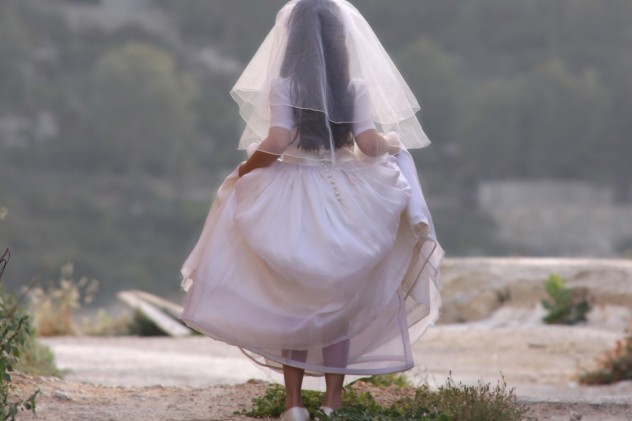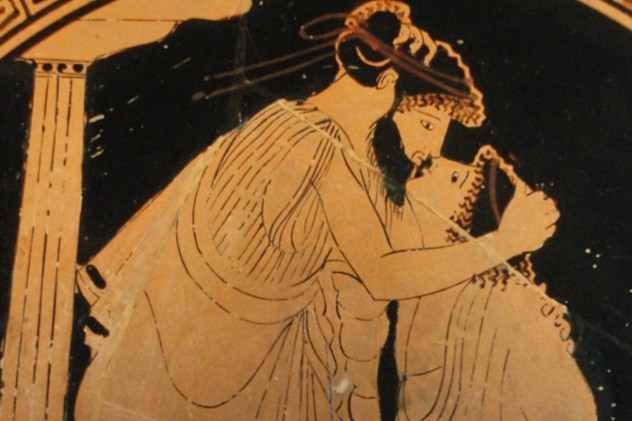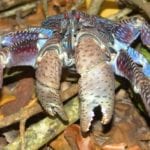 Creepy
Creepy  Creepy
Creepy  Technology
Technology 10 Scientific Breakthroughs of 2025 That’ll Change Everything
 Our World
Our World 10 Ways Icelandic Culture Makes Other Countries Look Boring
 Misconceptions
Misconceptions 10 Common Misconceptions About the Victorian Era
 Mysteries
Mysteries 10 Strange Unexplained Mysteries of 2025
 Miscellaneous
Miscellaneous 10 of History’s Most Bell-Ringing Finishing Moves
 History
History 10 Great Escapes That Ended Right Back in Captivity
 Weird Stuff
Weird Stuff 10 Fascinating Things You Might Not Know About Spiders
 Food
Food 10 Everyday Foods You Didn’t Know Were Invented by the U.S. Military
 History
History 10 Odd Things Colonial Americans Kept at Home
 Creepy
Creepy 10 More Representations of Death from Myth, Legend, and Folktale
 Technology
Technology 10 Scientific Breakthroughs of 2025 That’ll Change Everything
 Our World
Our World 10 Ways Icelandic Culture Makes Other Countries Look Boring
Who's Behind Listverse?

Jamie Frater
Head Editor
Jamie founded Listverse due to an insatiable desire to share fascinating, obscure, and bizarre facts. He has been a guest speaker on numerous national radio and television stations and is a five time published author.
More About Us Misconceptions
Misconceptions 10 Common Misconceptions About the Victorian Era
 Mysteries
Mysteries 10 Strange Unexplained Mysteries of 2025
 Miscellaneous
Miscellaneous 10 of History’s Most Bell-Ringing Finishing Moves
 History
History 10 Great Escapes That Ended Right Back in Captivity
 Weird Stuff
Weird Stuff 10 Fascinating Things You Might Not Know About Spiders
 Food
Food 10 Everyday Foods You Didn’t Know Were Invented by the U.S. Military
 History
History 10 Odd Things Colonial Americans Kept at Home
10 Unorthodox Forms Of Marriage
Opponents of same-sex marriage often claim that the traditional marriage of a man and a woman has been the universal standard throughout human history. While it has indeed been the most common form of marriage since the dawn of agriculture, there have been a variety of different conceptions of the marital institution throughout history.
10 Polyandry

The counterpoint to polygyny is polyandry, wherein a single woman is married to multiple men. This system has historically been extremely rare. Polyandry is practiced in the modern world in a few isolated villages on the Tibetan plateau. For those cultures, polyandry has served as a way to keep family property together in regions with limited amounts of arable land and high birth rates. It’s a form of family planning. A group of brothers marries a woman of a similar age, and they all live and work together. The children of the family call the oldest husband “father” and the rest of the husbands “uncle.”
With increased cultural influence and education, the practice of polyandry is beginning to die out, but recent evaluations of the practice have found it was not as rare throughout history as many have assumed. Polyandry has been documented in communities from the Arctic to the Amazon. These unions generally emerge in response to environmental conditions and a lack of fertile women, almost always in relatively egalitarian societies.
There are many advantages of this kind of arrangement. The presence of multiple men creates a greater sense of safety within the family. Studies on the “father effect” among the Bari people of Venezuela have shown that children with multiple recognized fathers are more likely to survive than those who have only one.
Some have proposed polygyny as a solution to the problem of the gender gap in modern China and India, but it is an unlikely match for societies with complex bureaucracies and class systems.
9 Levirate And Sororate Marriages

Under this system, marriage is seen less as a union of two individuals and more as an alliance between families that must continue even after the death of a spouse. It emphasizes the rights and obligations between kin groups. In a levirate marriage, a man marries the widow of his deceased brother. In some cases, children born of the union are considered the sons of the first husband. They remain part of his descent group and and are therefore prevented from being separated from their mother. Levirate marriages are practiced in tribal communities in the Americas, Africa, India, and Australia.
In a sororate marriage, practiced among native tribes in North America and India, a deceased woman’s kin group offers a sister as a wife to the widower. Some cultures arrange sororate marriages if the first wife proves to be barren. The children born of the second wife are considered to belong to the first. In situations when a suitable brother or sister is not available for marriage, other appropriate kin relations may be offered instead.
8 Nikah Mut’ah

Popular in the ancient Islamic world, nikah mut’ah refers to a kind of temporary marriage. They were sometimes known as fixed-term or pleasure marriages. This form of marriage was a temporary contract between a man and a woman with a fixed time limit. There were traditionally a number of restrictions: A man could only marry a Muslim, Christian, or Jew, though it was heavily recommended to temporarily marry only chaste Muslim women. Muslim women were not allowed into arrangements with non-Muslims.
If a man already had a wife, he needed to get her permission before entering into an arrangement. If he wanted to marry a slave, he required the permission of her master. The two main conditions of a temporary marriage are a stipulated time period and a dowry. The Prophet Muhammad is said to have engaged in a temporary marriage contract.
While nikah mut’ah is considered permissible by Shia Muslims, it is forbidden to Sunni Muslims. While they acknowledge it was permissible in the early days of Islam, they point out verses in the Quran that forbid sexual intercourse with anyone other than one’s legitimate wife or a slave. They claim the practice was forbidden by the second Muslim Caliph, Umar ibn al-Khattab.
Today, the practice is used in Iran as a cover for prostitution rings. This has led to backlash among communities, but some ayatollahs have asked the government to organize specific centers to arrange temporary marriages between men and women. In the UK, nikah mut’ah is used for young Muslim couples to date within the confines of sharia law. This is seen as a way to balance traditional beliefs with a modern Western lifestyle.
7 Ghost Marriage

In many parts of the world, it is permissible to wed someone who has already died—or for two dead people to get married. In China, a bachelor who has died must be buried next to a woman so he will not be alone in the afterlife. Tomb robbers have been caught digging up unwed women for these ghost marriages. The price for freshly deceased female corpses ranges from 16,000 to 20,000 yuan ($2,600–$3,300).
The reasons for ghost marriages are varied. One custom holds that a younger brother must marry after his elder brother. If the elder brother dies, he is given a ghost marriage to prevent the younger brother being haunted by his vengeful sibling after getting married himself. Among Singaporean Chinese, it is more common for two deceased people to be given a marriage ceremony by their relatives. There are even ghost marriage brokers. In some occasions, funeral ceremonies and marriage ceremonies may coincide.
Ghost marriage is also practiced among the Nuer and Atuot people of southern Sudan. If a Nuer or Atuot man dies without an heir, one of his brother’s wives will marry his ghost. Any children she produces will be considered heirs to the deceased brother. A similar practice known as epikleros was practiced in ancient Greece.
In Japan, the tradition diverges from other places. The deceased is wed to a doll that represents a spirit bride linked to the Buddhist bodhisattva Jizo. A doll representing the deceased is enshrined with its bride or groom spirit doll for up to 30 years. This form of ghost marriage developed in the 1930s in the Tohoku region in response to large numbers of young, unmarried men dying in wars in Manchuria. It was popularized throughout the country following a televised documentary on the practice.
6 Complex Marriage
John Humphrey Noyes formed a utopian community in upper New York State known as the Oneida Community during the 19th century. He believed Christ had risen, the kingdom of Heaven was swiftly approaching, and human beings were capable of reaching perfection in this world. He pointed to biblical references to the nonexistence of marriage in the kingdom of Heaven as justification for the practice of complex marriage. Every man in the community was considered equally married to every woman. Monogamy and sexual jealousy were considered sinful and idolatrous. Community members chastised those who seemed to be drifting into monogamous arrangements.
In order to reduce the birth rate and assure sexual pleasure for women, Noyes preached the practice of “male continence,” or engaging in intercourse without ejaculation. This was supposed to promote self-control. The system gave far more control over sex to women than was common at the time. Each woman was free to accept or reject the sexual advances of any man. This allowed for the development of an egalitarian society where women were accepted as equals to men, possibly contributing to the community’s economic successes.
The downside was a creepy system of sexual indoctrination. Shortly after puberty, teenagers were assigned a succession of much older sexual partners in a practice known as “ascending fellowship.” The purpose was to introduce the youngsters to the holy powers of sex. Noyes allegedly initiated a number of 12- and 13-year-old girls. There was also a makeshift eugenics program that paired up sexual partners to produce allegedly superior children.
The community lasted for three decades before it disbanded partially due to increasing dissatisfaction with the institution of complex marriage—but also due to Noyes fleeing to Canada following charges of statutory rape.
5 Devadasi
In this south Indian practice, a young girl was married to a deity or a temple. The word “devadasi” literally translates to “maid servant of god.” Some girls were married to a god or temple before birth. They had to be attractive, hardworking, intelligent, and skilled dancers. Their duties were to sing and dance in the morning and evening in honor of their god, gaining revenue for their temples through donations from onlookers. They were also expected to attend marriages and other ceremonies in order to bring auspiciousness. The devadasi were traditionally highly respected and had higher status than other women in society. It was considered an honor to be married to a god.
In time, the practice became corrupted, and the devadasi were used as prostitutes by aristocrats and priests in order for temples to earn money. Some say this was due to temples being taken over by the Brahmin caste after the fall of Buddhism in India—Buddhist nuns were also used as prostitutes. Soon, daughters of poor or lower-caste families were sold to temples where they were initiated into prostitution. They were known as jogini and were forbidden to get married as they were already wed to a god or goddess.
The tradition, which was mostly tolerated under British rule, was finally made illegal in India in 1988, but the practice still exists between members of the untouchable caste and some rural temples. Young girls are inducted into sexual exploitation and violence only to be discarded when they are no longer considered attractive. One former devadasi, now blind and reduced to living off scraps given by devotees, described it to the Guardian: “My mother, a devadasi herself, dedicated me to Yellamma and left me on the streets to be kicked, beaten, and raped. I don’t want this goddess any more, just let me die.”
4 Child Marriage

One of the greatest arguments against the conservative notion of the superiority of traditional marriage is that many traditional, heterosexual marriages would be considered highly immoral and disgusting by modern standards. The clearest example is that of child marriage. In medieval Europe, girls were usually married at the age of 12. This made sense due to the extremely short life expectancy rates at the time, but it was taken to extremes that modern people would find highly disturbing. Girls were eligible for marriage at the age of seven.
The concept of childhood did not exist. People were treated as adult members of society as soon as they weren’t dependent infants, usually between the ages of five and seven. The developing economy helped to increase the age of majority and allowed for the development of the concept of childhood as a separate stage from infancy and adulthood.
While child marriages eventually vanished in Europe, they are still practiced in many developing parts of the world despite active efforts to reduce them. Many girls are forced or sold into marriage with much older men as a way to reduce their economic burden on their families. The marriage of pubescent girls is common throughout sub-Saharan Africa, South Asia, and parts of the Islamic world, while the marriage of prepubescent girls occurs in West and East Africa and parts of the Indian subcontinent.
One hot spot for the practice is Yemen, the poorest country in the Arab world. In rural areas, girls may be married as young as eight years old. Fourteen percent of girls are married by 15, 52 percent by 18. An attempt to set a minimum age at 17 in 2009 was rebuffed by conservative lawmakers who deemed a minimum marital age as contrary to Islamic law, though Muslim human rights activists disagree.
3 Tongqi
In China, there is immense social pressure to get married and produce an heir. Acceptance of homosexuality is extremely low compared to many Western countries. One solution for many homosexual men has been to take heterosexual wives. One Chinese sexologist claims such marriages account for 90 percent of homosexual men in China. These are known as tongqi marriages, combining the word tongzhi, meaning comrade and a euphemism for homosexual men, with the word qizi, meaning wife. The downside of these marriages is the female partner often has no idea of her husband’s sexuality before entering the marriage and is soon plagued by feelings of rejection and sexual dissatisfaction.
On the other hand, there is an increasing movement among Chinese homosexual men and women to marry one another in what are called “cooperative marriages.” Organized online and through social media, these marriages allow the couple to satisfy their parents and wider society with a marriage and potentially children, while providing mutual support to one another and maintaining separate relationships on the side. In one such cooperative marriage, the groom’s partner was his best man, while the bride’s partner was the maid of honor. Some gay advocates in the West criticize these marriages as reinforcing heterosexual marriage norms within society rather than challenging them.
2 Spirit Spouses
The Baule people of the Ivory Coast believe that everyone has a spirit spouse to whom they were married in the spiritual realm before they were born. They’re called blolo bian (“other-world man”) or blolo bla (“other-world woman”). Marital strife between an earthly couple is sometimes blamed by spiritual guides on jealous or unhappy spirit spouses. The spirit guides advise carving a wooden representation of the spirit spouse, which is carved to resemble an idealized image, oiled, clothed, and adorned before being placed in a shrine. This is said to appease the spirit.
Some anthropologists see the spirit spouses as a way for the Baule to externalize personality traits belonging to the opposite gender. It’s possible to communicate with spirit spouses in dreams. Because they stand between the spirit realm and the real world, they are treated as if they were a real person. One Baule woman reported that her earthly marriage became much happier after she made a shrine to her spirit spouse, though she considered her human and spirit spouses rivals. On some nights, she would sleep with the wooden carving of her spirit spouse. On others, she would sleep with her earthly husband.
1 Traditional Same-Sex Marriage

Same-sex marriage is considered a recent innovation by some conservatives. US Supreme Court Justice Samuel Alito called it “newer than cellphones or the Internet.” In reality, forms of same-sex marriage have existed throughout history. In the 1960s and ’70s, some gay rights activists were granted the right to marry, though it was not until the 1990s that the Gay Rights Movement began in earnest.
Evidence of sanctioned same-sex relationships from the ancient world is rare, but common acceptance can be gleaned from looking at Babylonian literature, Greek social mores, and a tomb for two male courtiers from the Fifth Dynasty of Egypt with depictions of the pair in a passionate embrace.
There is more evidence of same-sex marriage in ancient Rome. Emperor Nero married a eunuch in a large ceremony. The poets Martial and Juvenal both described homosexual marriages, the former dismissively and the latter calling it “a small affair,” but considering it rather decadent.
Same-sex marriages were common enough to induce an official prohibition against them in the third century AD after the conversion of the Roman Empire to Christianity. The early Catholic and Greek Orthodox Churches practiced adelphopoiesis, or “brother-making” ceremonies. Historians disagree about whether these marriages were based on love. The institution did indeed involve rituals, vocabulary, and legal implications similar to heterosexual marriage. The practice wasn’t widely accepted in many European countries and was condemned by the Byzantine Emperor in the 14th century, but it endured past the 16th century in some parts of Greece and the Balkans.
In Native American cultures, the concept of the third sex allowed for same-sex marriage. The most prominent example was We’wha, who was married to a man while being the foremost Zuni representative to the United States. The first study about same-sex unions was of the Mohawk tribe, which allowed for berdache marriages as a socially accepted institution. Most Native American tribes that recognized such marriages did so as long as one partner took an opposite gender role in the society. Among the Mohawk, homosexual men were considered good partners as they were “exceptionally industrious wives,” but were considered difficult to divorce because “they might beat you up.”
Some African cultures also believed in and accepted same-sex unions, though they were often intergenerational, as with the Azande “boy-wives” and Basotho “mummy-daughter” relationships. Some African cultures allowed for “female husbands”—women who took wives and the legal and social roles of father and husband. Same-sex ceremonies imitating marriage were apparently common in southern China during the Yuan and Ming dynasties, while women of the Qing dynasty who renounced marriage and joined spinster houses known as sou hei sometimes formed lesbian couples and engaged in marriage ceremonies.
A similar institution emerged in 19th-century America in the form of “Boston marriages,” which referred to two women who lived together independent of men. These were generally accepted, though what went on behind closed doors is mostly unknown. For some, it was likely more about mutual support and independence. For others, it was just as much about finding a way to exist in a socially accepted homosexual union. Regardless, the history of same-sex marriage and unions is long and extends across a number of cultures and continents, despite the traditional Judeo-Christian bias against it.
David Tormsen is betrothed to his parallel timeline XX-chromosome analogue Rebecca. Email him at [email protected].




